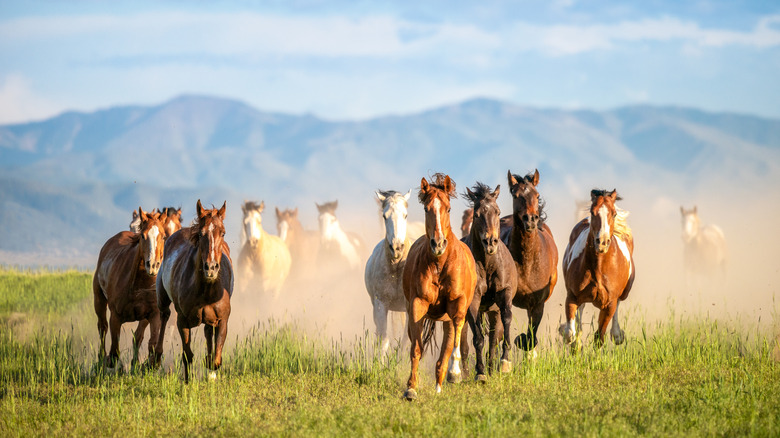The wild mustang is one of the purest symbols of American pride. Mustangs are powerful and free. They thrive in the most untouched corners of the American hinterlands. Like bison and bald eagles, wild horses are inherently noble, timeless denizens of open spaces. Most of us could only dream of seeing these iconic creatures up close.
You can find them in pockets all across the United States. Domesticated horses are easy to find, and there are many great places for a spot of horseback riding across the planet. But wild horses are a different breed, and the reality of “feral” horses is a little more complicated than the postcards would let on: Modern horses aren’t native to the Americas and only arrived with European colonists. Almost every wild horse is descended from an animal that escaped domestication, and brutal roundups were routine until the Wild Free-Roaming Horses and Burros Act of 1971, which protects the mustangs on many parcels of land, though hardly all.
What does this mean for horse enthusiasts dying to see these majestic animals in the wild? Well, finding a mustang can take some work — and maybe a knowledgeable guide. As with all wildlife, visitors should respect the horses, keep a safe distance, and obey local rules. For the best places in the U.S. to find wild mustangs, we consulted the U.S. Parks Service, Bureau of Land Management, and crowdsourced reviews on Yelp and Tripadvisor. Here’s where to follow in their hoof prints.
Virginia Range, Nevada
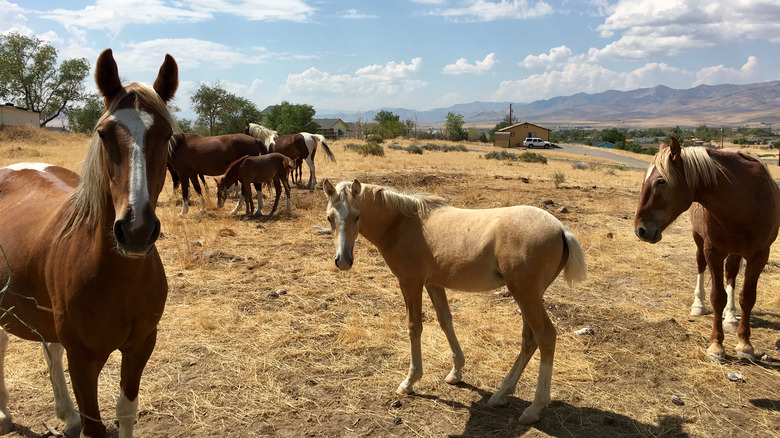
If you had to place a bet, the best spot in the United States to see wild horses is Nevada’s Virginia Range. The total population of mustangs ebbs and flows, but somewhere between 2,000 and 3,000 are said to currently roam this mountainous region on the western edge of the Silver State — the odds are good that you’ll track some down. This dusty, high-peaked area may seem like a wilderness, but most of these 500 square miles are within a reasonable drive of Reno, which has a well-connected airport and lots of tour operators to consult.
This herd is significant because of Velma Bronn Johnston, nicknamed Wild Horse Annie, who grew up in Reno and is the most famous feral horse advocate in U.S. history. These were the horses that inspired her decades of activism, not only to protect the mustangs but to prevent the brutal, lawless roundups that used to take place here. There are several areas in Nevada known for wild horses, but the Virginia Range is a well-established destination, and the wide-open landscape makes this gigantic herd easy to spot.
Chincoteague and Assateague Islands, Virginia and Maryland
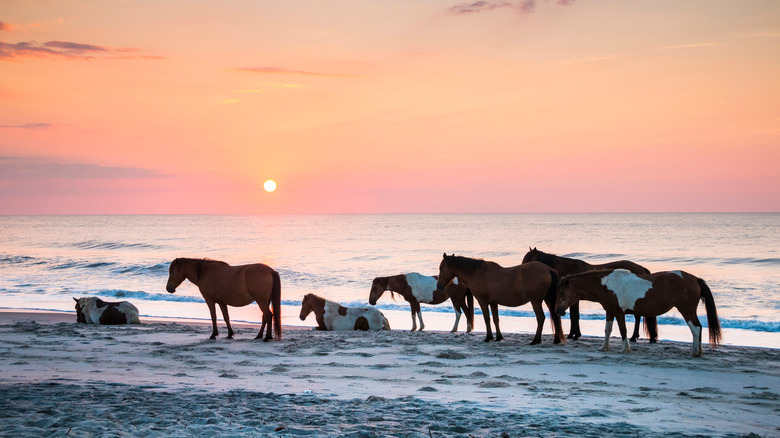
Perhaps the most famous location is this chain of islands off the coast of Virginia and Maryland, thanks to Marguerite Henry’s acclaimed children’s book, “Misty of Chincoteague.” Assateague is an uninhabited barrier island, and Chincoteague is an adjacent island with a small town; outsiders tend to use these names interchangeably. The “Chincoteague ponies” here are world-famous, and the tightly controlled herd averages about 150 animals, which can be spotted grazing on coastal grasses or shading themselves under trees. The herd births about 70 new foals yearly, so you can expect to spot shaky little ones, especially in the spring.
The exact origins of the horses are uncertain, but many suggest that they came from a single shipwreck, which was once common along this shallow shore. Hiking and off-road tours are easy to arrange, and visitors are welcome to drive in independently after paying a vehicle fee. Camping is a popular pastime on Assateague, with beautiful oceanside views, and equestrians are invited to ride the trails on their own (domesticated) horses and stay at special “horse camps.” Infrastructure across the island is designed with accessibility in mind, including ramped walkways and “beach wheelchairs” available upon request. While you’re in the area, remember to check out some of Virginia’s most charming small towns.
Steens Mountain Wilderness Area, Oregon
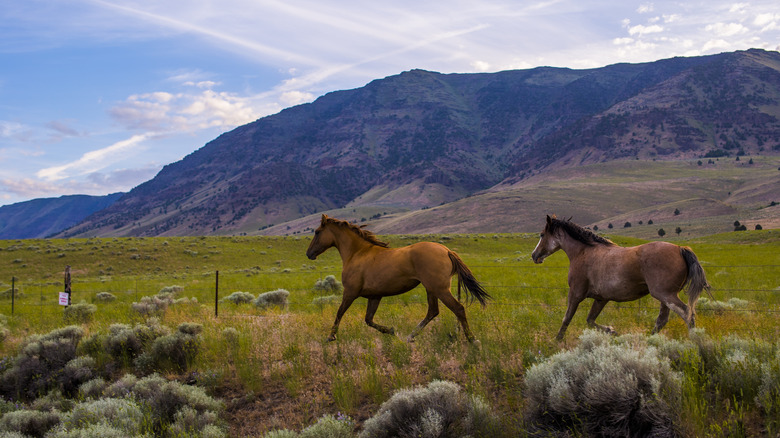
BuckTheSystem/Shutterstock
The Kiger mustang is a special breed of horse native to the isolated southeastern grasslands of Oregon. The horses are famous for their “dun” coloring, and their ancestors most likely arrived in the region with 17th-century Spanish colonists. If your impression of Oregon revolves around hipster cities and rainy forests, this quadrant of the state will defy expectations with its wide-open grasslands, corrugated mountain ranges, and isolated stretches of desert. This is the landscape the Kiger horses call home, and visitors have to work to get here; Steens Mountain stands a six-hour drive from Portland’s International Jetport, and only a handful of small towns are scattered along the highways.
Kiger numbers vary from year to year, and they run free across a vast swathe of land. Unless you’re a skilled tracker, consider a stay (and tour) with the Steens Mountain Guest Ranch, whose hosts specialize in spotting the elusive creatures. Not only will expert guides take you to the Kiger mustangs in their natural habitat, but you can get there in the most fitting possible way: in the saddle of a horse. Reservations are competitive, so you may also find yourself setting up a tent or RV at one of the local campgrounds.
Theodore Roosevelt National Park, North Dakota
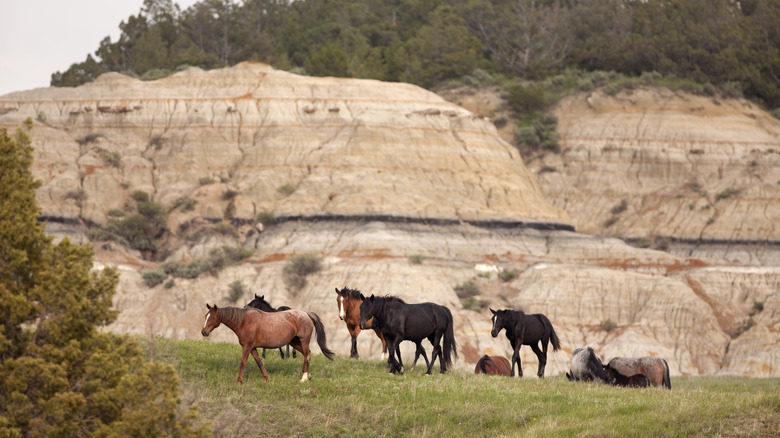
Milehightraveler/Getty Images
If you know anything about Teddy Roosevelt, you might assume that America’s “cowboy president” would love the idea of feral horses running free across a national park named after him. Roosevelt was an expert horseman and spent much of his youth riding around “The Dakota Territory.” Many believe his time in the Dakotas informed Roosevelt’s later enthusiasm for land conservation.
At the time of writing, Theodore Roosevelt National Park does have scattered herds grazing in its grasses, and visitors may spot them in the wild. However, the fate of these horses has been controversial for decades, as they aren’t technically protected by the Wild Free-Roaming Horses and Burros Act and could be legally rounded up and removed at any time. Park officials urge extreme caution around the horses and advise viewing them through binoculars. That said, the park is spread over 70,000 acres of scenic badlands, and bison, elk, and prairie dogs are also common sights. Most road-trippers shouldn’t visit the park with the express purpose of finding horses, but it’s a very special encounter if you do. You’re also welcome to trot the park’s many bridle paths, which were likely taken by the Rough Rider himself.
The Pryor Mountains, Montana and Wyoming
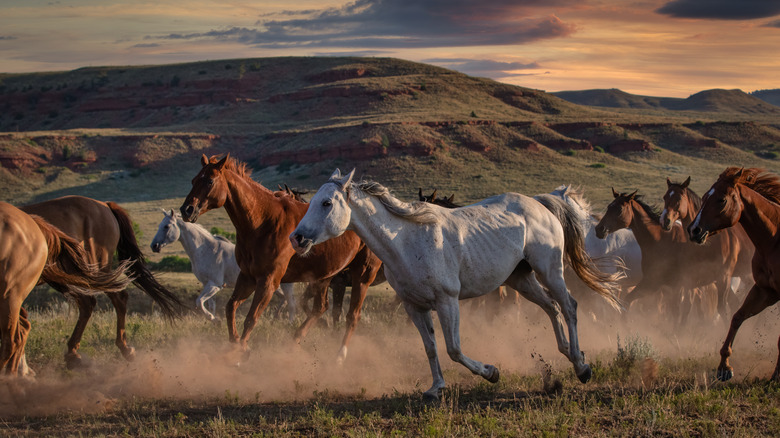
Christy berry/Shutterstock
More than 100 mustangs gallop across the 38,000 acres of the Pryor Mountain Wild Horse Range, which was named a protected area in 1968. Straddling the Montana-Wyoming border, the Pryor Mountains boast the kind of rugged, grassy, evergreen-studded landscape that calls for cowboys in dusters. Come prepared; the closest city is Billings, about 50 miles away, and the back-country roads may punish your axle. While you should stock up on supplies before you venture out this way, the camping regulations are extremely lenient, allowing responsible, no-trace backpackers to set up their tents almost anywhere. Many visitors may feel about as free as the horses they hope to spot.
If you can’t look at a hoof print in the dust and tell how fresh it is, you may want to reserve a tour with PryorWild, based in nearby Lovell, Wyoming. This family operation knows the horses’ migration patterns and leads visitors into the country to find and photograph them, and there’s even a bunkhouse for overnights. The Pryors can be a demanding environment, so keep this in mind before you join an organized tour or even try to rough it on your own.
Waipi’o Valley, Hawaii
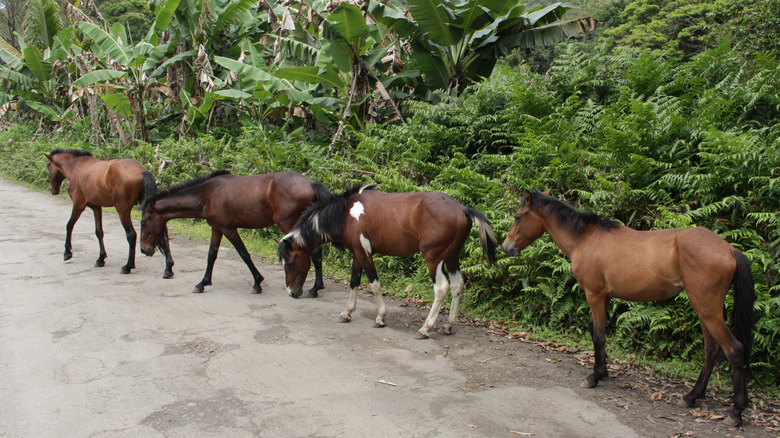
Colleen Bradley/Getty Images
When most people imagine wild horses, they don’t picture the verdant tropical mountains of Hawaii. The Waipi’o Valley is an Edenic wedge of river and land that eases into the Pacific Ocean, sparsely peopled and overflowing with biodiversity. One species that roams the Waipi’o is the wild horse, which visitors can spot on trails and roadsides throughout the region. Why are they there? The valley was once well developed, first by Indigenous Hawaiians and later by immigrants, but a 1946 tsunami wrecked most settlements, and residents were hard-pressed to rebuild, making Waipi’o a case study in “re-wilding.”
This area is remote, located on the northern tip of the Big Island, right next to the Pu’u Omi Natural Area Reserve. There are lots of nooks like this in Hawaii, the type of places that only locals know. Still, it’s only a 70-minute drive from Hilo, the island’s biggest town, and the 2,000-foot slopes and diverse climates make this region worth the drive. Spotting horses will depend greatly on their movements and Hawaii’s complex weather patterns, but it’s possible they will emerge from the dense vegetation, just as they have since the days of the 19th-century colonists.
McCullough Peaks, Wyoming
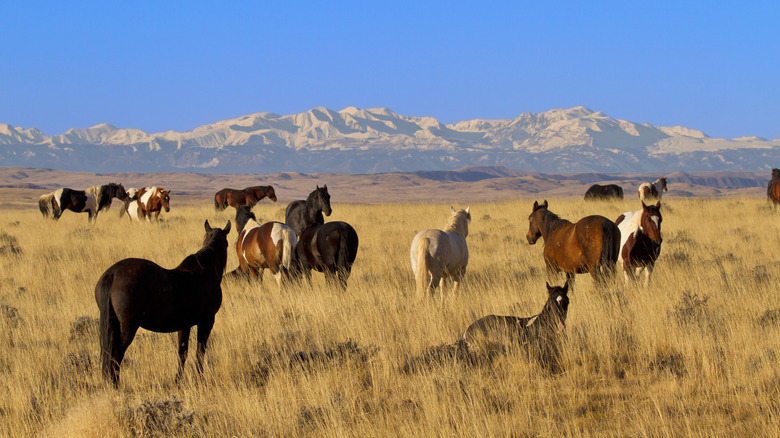
Florence-Joseph McGinn/Shutterstock
It’s hard to picture 109,814 acres, and the four-season desert of the McCullough Peaks Management area can feel extremely remote. Amazingly, this protected land is a reasonable drive from a few well-trod places, including Cody, Wyoming (12 miles), and Yellowstone National Park (70 miles). If you’re taking a trip across Wyoming, the ruffled grasslands of McCullough Peaks are a majestic place to stop — especially if you’re on the lookout for horses.
The herds of McCulloughs Peak come in a striking variety of colors, representing the many breeds that have congregated here over the years. The total population hovers between 150 and 200 animals spread over a massive amount of land, so finding them may require serious effort. One advantage is the near-absence of trees, so visitors can see for miles in any direction. Be advised: Population control measures by the Bureau of Land Management can be a sore subject among locals, and although the land is arid, winter travel in Wyoming can get downright frigid.
Cumberland Island, Georgia
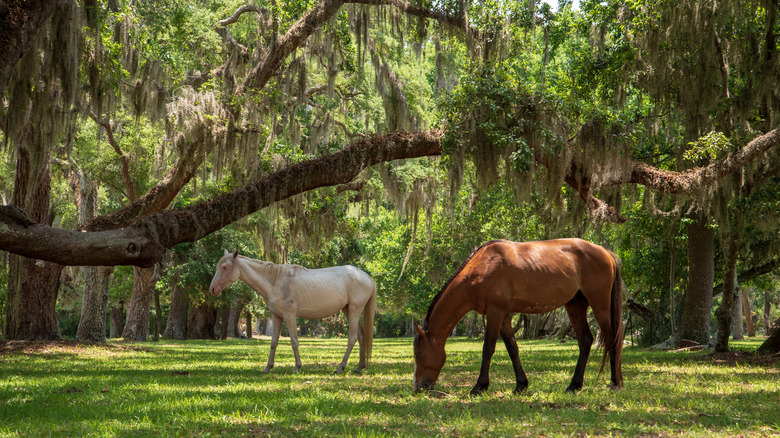
jctabb/Shutterstock
Cumberland is a barrier island off the coast of Georgia, but unlike so much scenic ocean property, this land mass is mostly undeveloped; 9,800 acres are Congressionally designated wilderness. Cumberland is an island of quiet roads for biking, pleasant plots for camping, and plenty of open land for wild horses to roam. You can find them among the coastal dunes or near the stone ruins of the Dungeness mansion. Over the centuries, Cumberland Island has attracted an eclectic bunch, including Indigenous populations, people escaping slavery, and eccentric settlers weary of mainland expectations. With these migrations came horses, many of whom wandered off to live independently. Today, only about 40 residents live on the island full-time, and about 300 visitors spend a day here in the high season.
Unlike other feral populations on the East Coast, the Cumberland horses live in complete autonomy. No authority controls their population or provides medical care; the horses are both free and must fend for themselves. Visitors are discouraged from walking within 50 feet of any horse, and all vehicles must yield right of way.
Tonto National Forest, Arizona
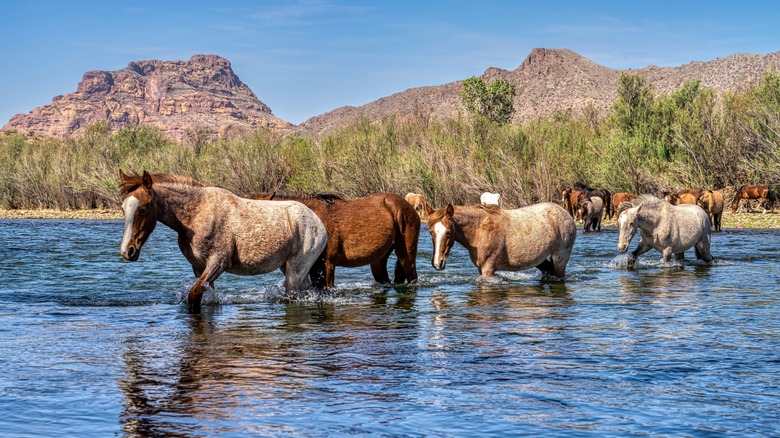
Brent Coulter/Shutterstock
In photos, Tonto looks like a craggy desert, and some may balk at the phrase “National Forest.” Tonto owes this distinction to its dizzying range of desert flora, notably the tall-standing saguaro and other varieties of cactus. This parched land may also seem an unlikely habitat for horses, but several hundred specimens are known to graze along the banks of the Lower Salt River, where they find water and grass aplenty. They have purportedly lived here for more than a century, back when Arizona was still considered a “territory.”
The horses here are a touchy subject among Arizonans, and local activists have faced off with the U.S. Forest Service about whether they should be considered “wild” horses or just unattended livestock that should be removed. At the time of writing, the horses have a right to remain, and you can reach them by hiking along local trails. Better yet, when the water is high, paddling a canoe or kayak in the Salt River can offer an even better view. As it happens, Arizona is also the best US destination for horseback riding adventures.
Outer Banks, North Carolina
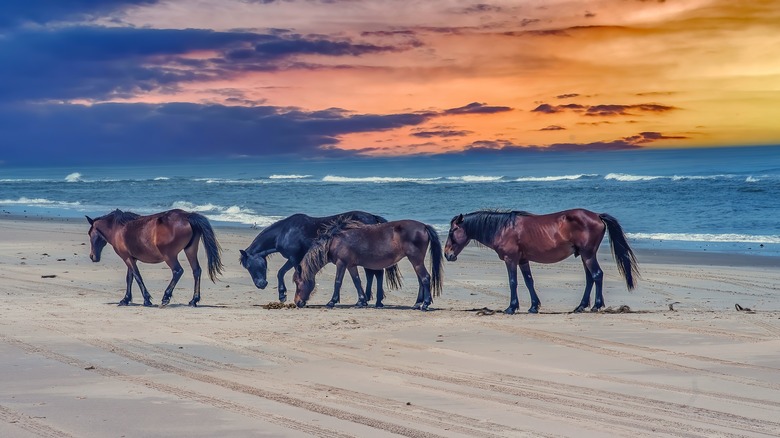
Prestigious PHotos/Shutterstock
The 100-mile strip of land known as the Outer Banks has become one of the most popular getaways in the American South, thanks to block after block of luxury cottages and beaches that seem to extend forever, perfect for coastal road trips. The oceanfront development along this barrier island would seem antithetical to wild horses, yet there they are, a herd of about 100 animals living in the grasses of Corolla, where their ancestors have resided for half a millennium.
Locals in Corolla take great pride in the “Breaker” horses, and visitors can easily arrange a guided tour. You are also welcome to bring a four-wheel-drive vehicle into the protected area; keep in mind that the horses are spread out over 7,500 acres and may not be easy for greenhorns to track, even in the bread-pan-flat topography of the Outer Banks. Local government is also serious about animal stewardship; no human can feed or pet a horse or even come within 50 feet of the animals, so make sure to bring that telephoto lens.
Little Book Cliffs Wild Horse Range, Colorado
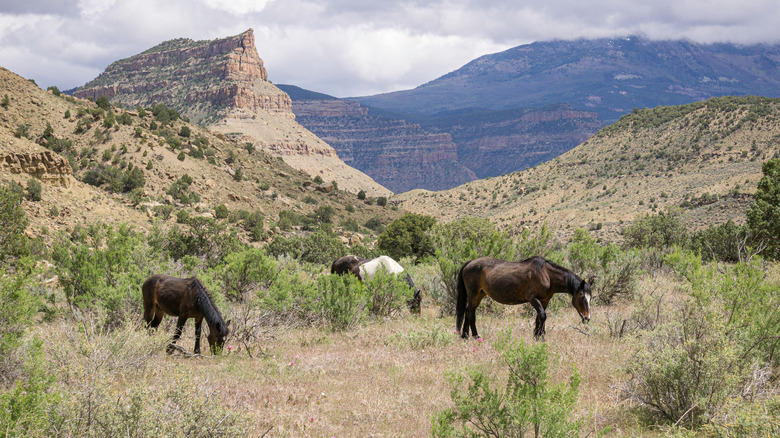
Cary Leppert/Shutterstock
Grand Junction is well named: The town marks an intersection of several major highways, and travelers through Colorado and Utah frequently stop here before venturing into the mountains of the east or the deserts of the west. Just a few miles out of a town, visitors will find the Little Book Cliffs Wild Horse Range, an intricate network of canyons and plateaus that is home to around 100 mustangs. These 36,000 acres can be challenging hiking, with steep trails and a scarcity of water, but there’s a good chance you’ll find a band of horses grazing in the arid scrub.
The Little Book Cliffs are a popular destination among tourists, all the more so because of their proximity to a well-trafficked town. Many assert that the horses are better acclimated to people and aren’t nearly as jumpy as other feral horses. Visitors should still exercise caution, and there are, of course, no assurances that you’ll find these horses in such a vast preserve. There’s plenty more to see here, including breathtaking rock formations, the sand-colored slopes of Mount Garfield, and abundant desert wildlife.
Return to Freedom Wild Horse Sanctuary, California
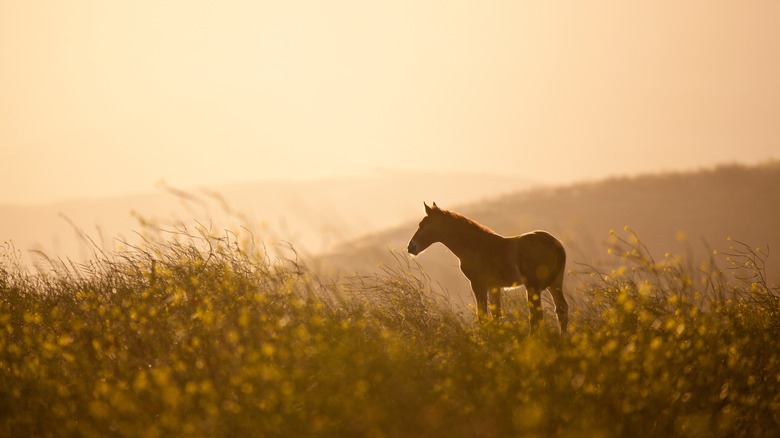
Cata Hula/Shutterstock
Most wild horses are found in national parks and management areas, but Return to Freedom is a special environment: This nonprofit organization is based in California and requires a reservation to visit. In an effort to protect mustangs from roundups and other human-led threats, the Sanctuary cares for more than 400 horses and 50 burros on its property. The story behind founder Neda DeMayo is extraordinary enough, but more striking still is Return to Freedom’s success. If you’ve ever wanted to care for a mustang yourself, the organization runs an ongoing adoption program.
Return to Freedom has two different locations, a 300-acre property in Lompoc and a 2,000-acre property in San Luis Obispo, both in California. Visitors can reserve a private tour and photo safari, or you can take one of the many classes on-site. Younger visitors may recognize Spirit, the horse that inspired the Dreamworks TV series “Spirit: Stallion of the Cimarron.” If you have some time to devote, Return to Freedom is always looking for animal-loving volunteers to help with their work.
Black Hills Wild Horse Sanctuary, South Dakota
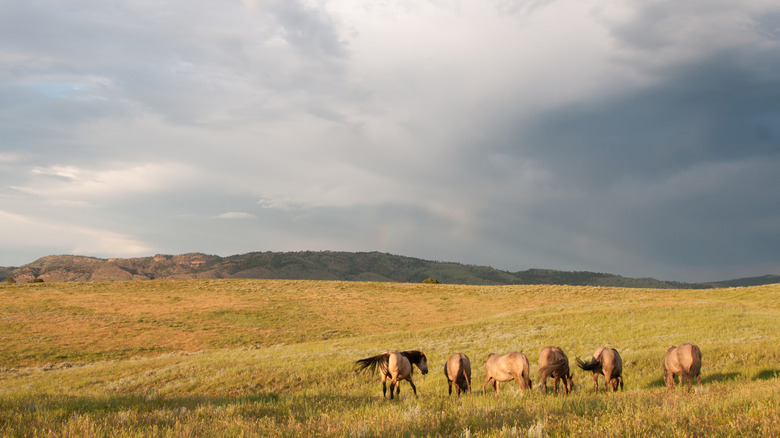
Karenparker2000/Getty Images
Nestled in the South Dakota highlands, the Black Hills Wild Horse Sanctuary is another refuge operated by a nonprofit organization, the Institute of Range and the American Mustang (IRAM), which has cared for the animals since the late 1980s. More than 300 horses run free on the property, and visitors can visit them on a specially arranged SUV tour.
A reservation is required, and the tour costs about $350. The organization’s website offers a small library of books and other resources, and you can also learn about IRAM’s formidable founder, Dayton O. Hyde. The Sanctuary’s 11,000 acres are breathtaking to behold and have served as a filming location for Hollywood movies and more. At its highest point, visitors can reportedly see 65 miles in every direction into three different states. Visitors may even be treated to the sight of prehistoric Indigenous petroglyphs near the river.
Sand Wash Basin, Colorado
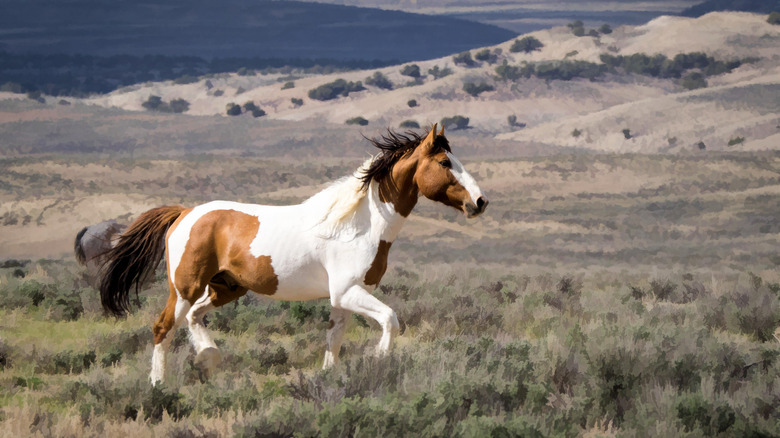
Nadja Rider/Shutterstock
If you really want to get away from it all, this is the place. There is no entry fee to visit Sand Wash Basin, the scrubby valley in the northeast corner of Colorado, and it’s free to set up a tent and stay the night. There’s minimal cell service out here; four-wheel-drive vehicles are recommended on these rough roads, and there is no consistent source of potable water. The nearest settlement is the tiny town of Maybell, 17 miles away, and the larger town of Craig is a full 47 miles away. You really have to want to visit this place, and you should come prepared for rustic conditions.
That said, this 166,000-acre region is home to more than 700 horses, making it one of the most populous herd management areas in the United States, and your chances of spotting them among the bald, rolling hills are very good, even without a knowledgeable guide. For many, this will make the long drive and rugged conditions worthwhile.
Onaqui Mountains, Utah
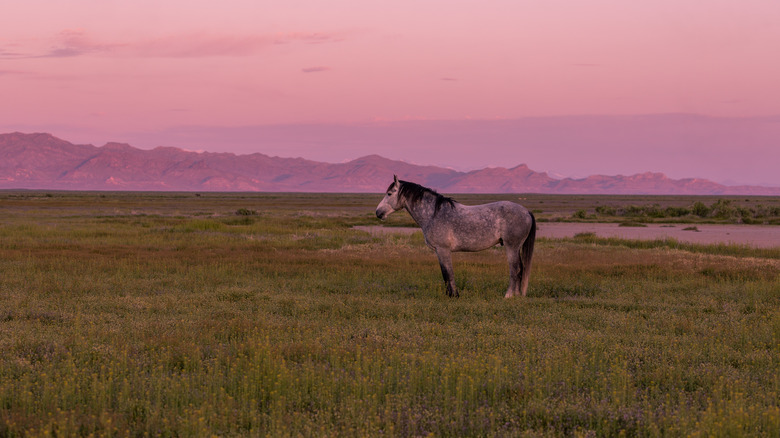
Tom Tietz/Shutterstock
The Onaqui Mountains are considered a part of Utah’s West Desert, and they intersect with an old Pony Express route. This is big-sky country, with spectacular peaks rising in the distance and juniper-dotted grasslands in between. The total population of mustangs fluctuates, and BLM roundups take place every few years, but numbers have risen as high as 450 horses. Of the many wild horse habitats in Utah, a drive down the gravel roads of the Onaqui Mountain Herd Management Area provides the most dependable views. The region may feel like the middle of nowhere, but it’s located only 60 miles down the road from Salt Lake City.
This area lies in the middle of the sprawling Tooele County, home of the famous Bonneville Salt Flats and 11,000-foot-high Deseret Peak. If you find yourself out this way, the Onaqui mustangs can be part of an even bigger Beehive State adventure like the incredible Mighty 5 road trip.
Our Methodology
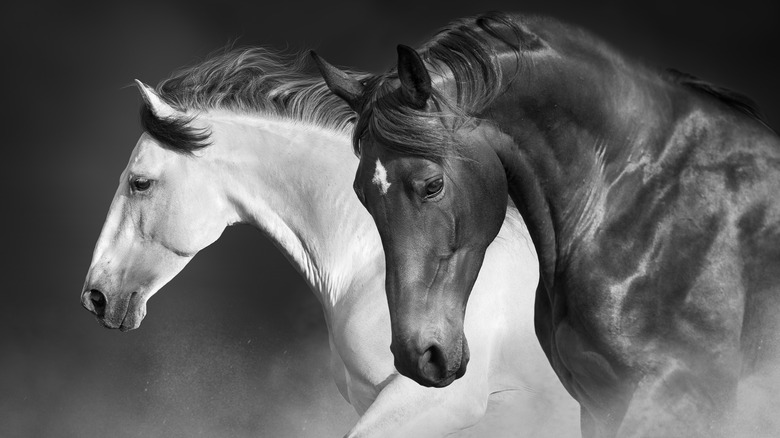
Kwadrat/Shutterstock
Aside from our personal experiences in many of these locations, we consulted several sites on the web, particularly Tripadvisor and Yelp, to find out where readers have had rewarding encounters with wild horses. This led us to many locations that are not typically listed in popular roundups. We reviewed online information from the Bureau of Land Management and the National Parks Service, which are rich in statistics and travel advice, as well as websites maintained by horse advocates and nonprofit administrators.

